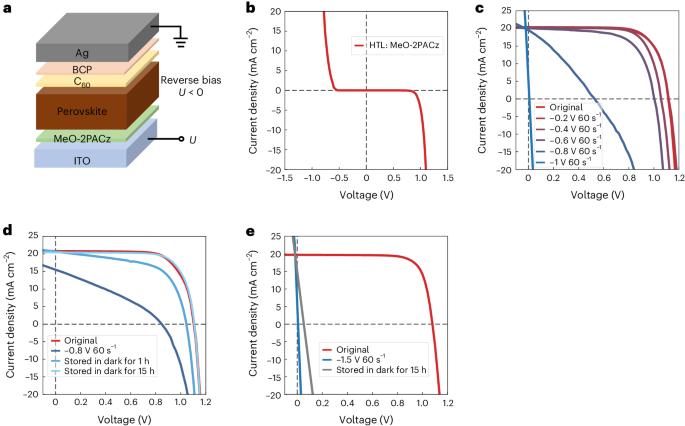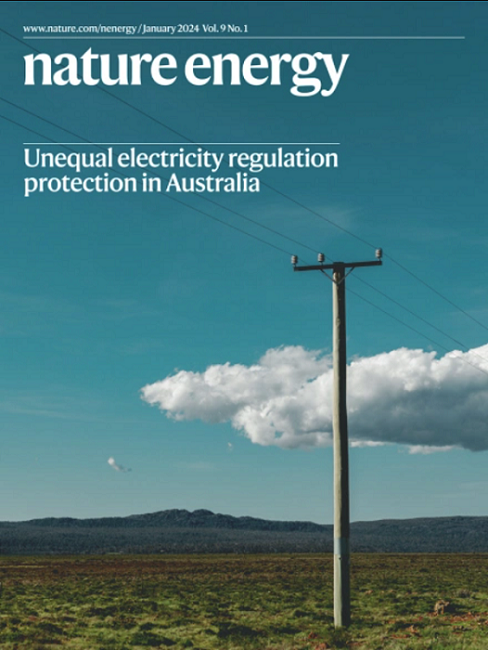Improved reverse bias stability in p–i–n perovskite solar cells with optimized hole transport materials and less reactive electrodes
IF 49.7
1区 材料科学
Q1 ENERGY & FUELS
引用次数: 0
Abstract
As perovskite photovoltaics stride towards commercialization, reverse bias degradation in shaded cells that must current match illuminated cells is a serious challenge. Previous research has emphasized the role of iodide and silver oxidation, and the role of hole tunnelling from the electron-transport layer into the perovskite to enable the flow of current under reverse bias in causing degradation. Here we show that device architecture engineering has a significant impact on the reverse bias behaviour of perovskite solar cells. By implementing both a ~35-nm-thick conjugated polymer hole transport layer and a more electrochemically stable back electrode, we demonstrate average breakdown voltages exceeding −15 V, comparable to those of silicon cells. Our strategy for increasing the breakdown voltage reduces the number of bypass diodes needed to protect a solar module that is partially shaded, which has been proven to be an effective strategy for silicon solar panels. Perovskite solar cells degrade when subjected to reverse bias. Jiang et al. show that relatively thick hole transport layers and metal back contacts with improved electrochemical stability afford better tolerance to reverse bias.


利用优化的空穴传输材料和反应性较低的电极提高 pi-n 型过氧化物太阳能电池的反向偏压稳定性
随着包晶光伏技术向商业化迈进,必须与照明电池电流匹配的遮光电池的反向偏压降解是一项严峻的挑战。先前的研究强调了碘化物和银氧化的作用,以及空穴从电子传输层隧穿到包晶体中,使电流在反向偏压下流动导致降解的作用。在这里,我们展示了器件结构工程对包晶石太阳能电池反向偏压行为的重大影响。通过采用约 35 纳米厚的共轭聚合物空穴传输层和电化学性能更稳定的背电极,我们展示了超过 -15 V 的平均击穿电压,与硅电池相当。我们提高击穿电压的策略减少了保护部分遮光的太阳能模块所需的旁路二极管数量,这已被证明是硅太阳能电池板的有效策略。
本文章由计算机程序翻译,如有差异,请以英文原文为准。
求助全文
约1分钟内获得全文
求助全文
来源期刊

Nature Energy
Energy-Energy Engineering and Power Technology
CiteScore
75.10
自引率
1.10%
发文量
193
期刊介绍:
Nature Energy is a monthly, online-only journal committed to showcasing the most impactful research on energy, covering everything from its generation and distribution to the societal implications of energy technologies and policies.
With a focus on exploring all facets of the ongoing energy discourse, Nature Energy delves into topics such as energy generation, storage, distribution, management, and the societal impacts of energy technologies and policies. Emphasizing studies that push the boundaries of knowledge and contribute to the development of next-generation solutions, the journal serves as a platform for the exchange of ideas among stakeholders at the forefront of the energy sector.
Maintaining the hallmark standards of the Nature brand, Nature Energy boasts a dedicated team of professional editors, a rigorous peer-review process, meticulous copy-editing and production, rapid publication times, and editorial independence.
In addition to original research articles, Nature Energy also publishes a range of content types, including Comments, Perspectives, Reviews, News & Views, Features, and Correspondence, covering a diverse array of disciplines relevant to the field of energy.
 求助内容:
求助内容: 应助结果提醒方式:
应助结果提醒方式:


